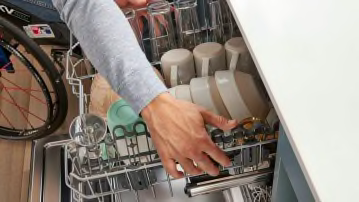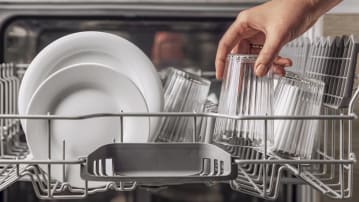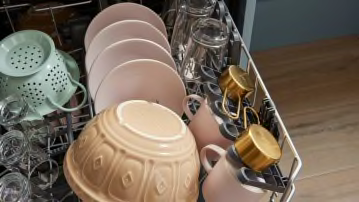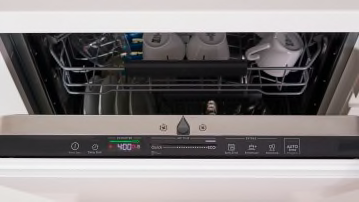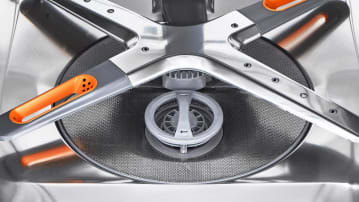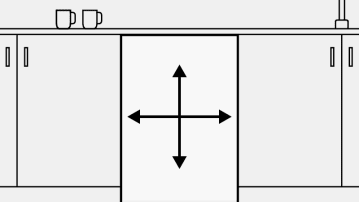Choose the Right Dishwasher for Your Kitchen
Your dishwasher should wash and dry dishes really well—that’s a given. But what kind of extra features are there, and which of those dozens are right for you? Our comprehensive buying guide will help you choose the dishwasher that fits your needs the best.
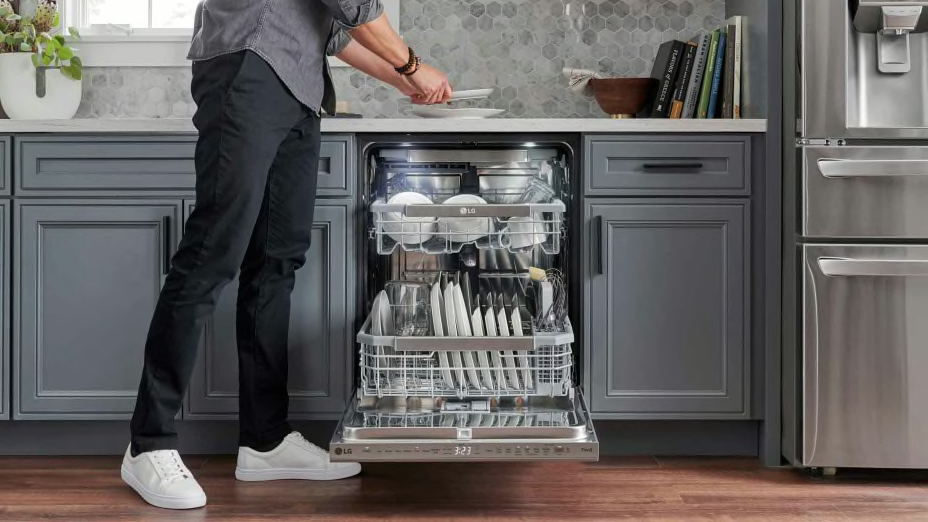
Photo: LG

Home & Appliances Writer
Top Dishwashers Questions
What should I look for in a good dishwasher?
Dishwashers have a pretty simple task: getting dishes clean. But you should expect a little more from the best dishwashers. Here are some of the most important qualities:
Powerful cleaning
A good dishwasher should thoroughly clean your dishes and leave them decently dry. Many dishwashers have a hard time getting things fully dry—especially plastic items, which are tougher to dry than glass or ceramic—but your appliance shouldn’t leave them dripping wet.
Quiet operation
The quietest dishwashers we recommend keep the noise level to a minimum. You won’t find a totally silent dishwasher, but the ones that score the best for noise in our tests keep the clanging and whooshing to a minimum.
Eco-friendliness
A good dishwasher is energy-efficient and uses minimal water to get things clean and dry. Dishwashers identified with our Green Choice leaf are energy- and water-efficient, and judged by CR to have less overall impact on the environment.
The right features
The best dishwasher features for you will depend on your needs and preferences, but a few things are desirable for just about anyone. A stainless steel interior tub is preferable to plastic because it’s more durable and stain-resistant; it also helps dishes dry more effectively. And some level of adjustability in a dishwasher’s upper rack ensures that all your dishes will fit.
What kinds of dishwasher features are there?
-
Stainless steel interior
Photo: BoschA stainless steel interior tub is more durable than plastic and stains less easily, meaning it will last longer. It also helps dishes dry faster. You might like the look better, too. But it will add to the price.
-
Adjustable upper rack
Photo: WhirlpoolSome models, especially at higher prices, offer flexibility in their upper racks. You can adjust their height to accommodate taller dishware.
-
Soil sensor
Photo: Getty ImagesMost dishwashers now have soil sensors, which detect how dirty your dishes are to determine how much water and time are needed to get them clean.
-
Third rack
Photo: WhirlpoolAbove a certain price, you’ll start to find third racks at the top of the dishwasher. They’re shallower than the two main racks and are usually designed to hold silverware or other flat items, like cooking utensils and pot lids.
-
Indicator light
Photo: IkeaSome dishwashers let you know when a cycle is running by shining a light on the floor. Some may even display the remaining time.
-
Adjustable tines
Photo: WhirlpoolMany dishwashers have rack tines that fold down to accommodate large or bulkier dishes. The areas of a rack where the tines are adjustable will vary among machines.
-
Hidden controls
Photo: IkeaDishwashers often have front-facing controls that are visible when you look at a closed dishwasher head-on. But you can also find “hidden controls” along the top edge of the dishwasher door for a sleeker exterior look.
-
Filter
Photo: LGFilters trap food scraps that wash off your dishes during a cycle. Most are manual filters that you'll need to clean out every now and then. But self-cleaning dishwashers pulverize food via a grinder so that it can drain away with the water.
-
WiFi
Photo: ThermadorAn increasing number of brands are building WiFi connectivity into their dishwashers so that you can monitor the machine or even start a cycle remotely by downloading an app to your phone.
What is the most reliable brand of dishwasher?
Along with testing dishwashers in our labs, we survey CR members about their appliances to find out how different brands perform over time. In our latest survey, we gathered responses from more than 66,000 members about more than 77,000 dishwashers across 27 brands, all purchased new between 2015 and 2025.
From the responses, we identified performance problems and breakages in these dishwashers and used those findings to predict the likelihood that a dishwasher from a given brand will develop problems or break in its first five years of service.
The survey results show that no brand is free of problems—and it’s worth noting that a brand’s quality can vary over time with changes in design and production. But some of the brands that rose to the top for predicted reliability were Bosch, Miele, Thermador, Beko, and Midea. Just behind these in reliability scores were Maytag, Whirlpool, LG, and Hotpoint. The most common problems members had with dishwashers were machines that failed to clean, followed by those that failed to dry well or drain away water, and dish racks that broke or stopped working properly.
To read more about the results from our latest survey, see our guide to the most and least reliable dishwasher brands. And if your dishwasher has broken down or needs repairs, you can use our interactive tool to help you figure out whether it’s worth paying for repairs as opposed to replacing the machine altogether.
If you’re looking for top performance and a reasonable price along with reliability, consider CR’s list of the best dishwasher brands overall. This list identifies dishwasher brands that come out on top when we combine our reliability scores with our testing results and price data. Shopping from our best brands list enables you to make an informed purchase, even if we don’t test the specific dishwasher model you’re interested in.
How do I know if a dishwasher is energy-efficient?
-
Hundreds of current dishwasher models qualify for Energy Star, a program created by the Department of Energy and the Environmental Protection Agency. In theory, an Energy Star certified dishwasher can cost about $50 per year to run and save you about 3,800 gallons of water over its lifetime.
-
The EnergyGuide label also provides estimated annual energy costs based on whether your home uses gas or electricity to heat water, and an estimate of the amount of electricity the dishwasher will use in a year.

What makes a dishwasher a CR Green Choice?
CR’s Green Choice program identifies products we have judged to have a less negative impact on the environment than others in the same category. Dishwashers that earn a Green Choice designation (indicated by a green leaf icon in our ratings) stand out in terms of their design, resource use (including water and energy consumption), and performance in cleaning and drying dishes.
Here are some specifics on each of these criteria:
Product Design
We examine the weight, dimensions, and materials used in manufacturing the product to assess the amount of resources utilized, and in some cases, the durability and recyclability of the product.
Resource Usage
We measure how much water a dishwasher uses to assess resource (water) consumption as well as the energy needed to heat that water. (Energy required to heat water is one of the largest contributors to a dishwasher’s overall environmental footprint.)
Performance
A dishwasher that fails to clean dishes effectively can lead to the need for rewashing, resulting in increased water and energy consumption.
Reliability
A reliable dishwasher provides years of service and is less likely to end up in a landfill prematurely. We base our reliability scores on annual surveys of dishwasher owners.
You can view CR Green Choice dishwashers in our ratings and read about the most eco-friendly dishwashers in our tests.
How should I pick a dishwasher?
-
Does the dishwasher fit my kitchen?
Illustration: Consumer ReportsMost dishwashers measure 24 inches wide and 24 inches deep. If you have a small kitchen, you might consider an 18-inch-wide dishwasher that's 24 inches deep. Measure your space, and don’t forget to account for the adjustment of the leveling feet.
-
Do my dishes fit the dishwasher?
Illustration: Consumer ReportsTake a close look at the configuration of the dishwasher’s interior to make sure the rack design will accommodate your dishes. If you frequently use oversized bowls or large casserole dishes, you may want a height-adjustable upper rack or fold-down tines on the bottom rack.
-
What features do I need for my dishes?
Illustration: Consumer ReportsThe more features a dishwasher has, the pricier it will be, so think through which extras you’ll actually use. For example, many models now come with WiFi, which offers cycle customization. But a good soil sensor means you shouldn’t have to hand-tweak a cycle.
How much should I spend on a dishwasher?
-
Gets dishes clean
$500 or Less
- Fewer models are available in this range
- Basic styling and fewer features
- Likely to have less durable plastic tubs
- Tend to be noisier
-
The Sweet Spot
$500 to $1,000
- Better styling and more finish options
- Top-rated for cleaning and reliability
- Tend to be quieter
- Tend to have more rack flexibility
-
Upscale styling
$1,000 or More
- More exterior finish options, including custom cabinetry
- Loaded with features such as rack flexibility, interior lighting, and hidden controls
- Many feature WiFi and smart features

















